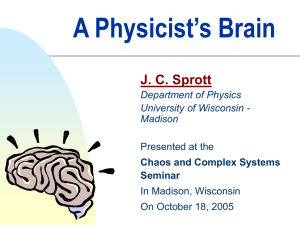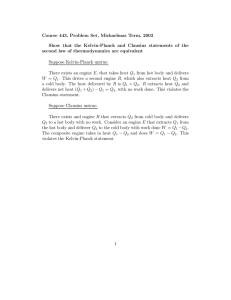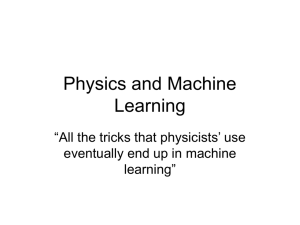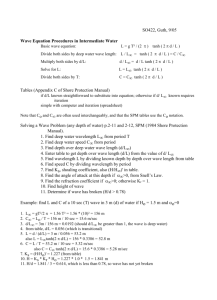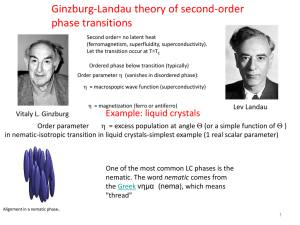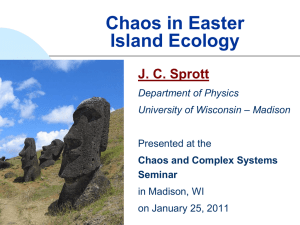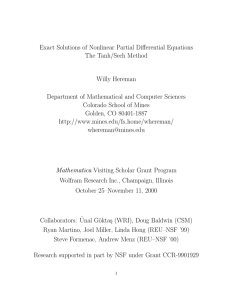Chaotic Dynamics on Large Networks
advertisement
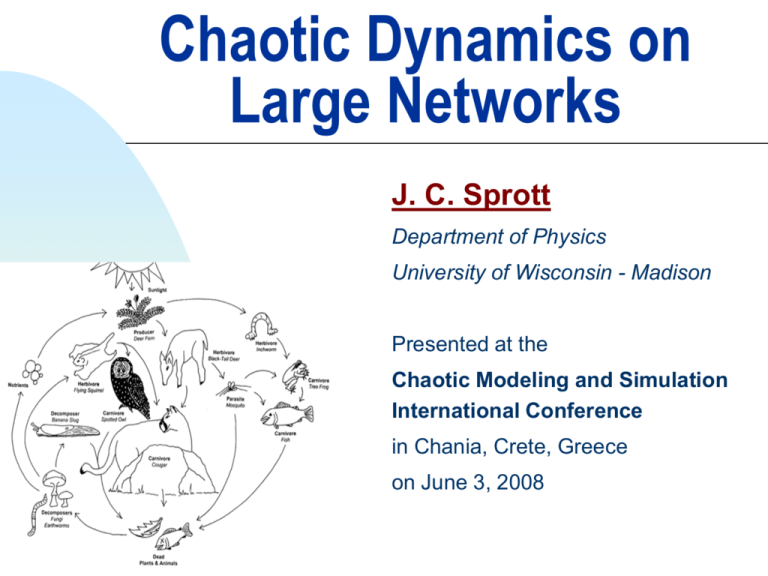
Chaotic Dynamics on Large Networks J. C. Sprott Department of Physics University of Wisconsin - Madison Presented at the Chaotic Modeling and Simulation International Conference in Chania, Crete, Greece on June 3, 2008 What is a complex system? Complex ≠ complicated Not real and imaginary parts Not very well defined Contains many interacting parts Interactions are nonlinear Contains feedback loops (+ and -) Cause and effect intermingled Driven out of equilibrium Evolves in time (not static) Usually chaotic (perhaps weakly) Can self-organize, adapt, learn A Physicist’s Neuron N N xout tanh a j x j j1 inputs tanh x x A General Model (artificial neural network) 1 N neurons 3 2 4 N xi bi xi tanh aij x j j 1 j i “Universal approximator,” N ∞ Solutions are bounded Examples of Networks System Agents Interaction State Source Brain Neurons Synapses Firing rate Metabolism Food Web Species Feeding Population Sunlight Financial Market Traders Transactions Wealth Money Political System Voters Information Party affiliation The Press Other examples: War, religion, epidemics, organizations, … Political System Information from others Political “state” a1 N Voter a2 a3 x bx tanh a j x j j 1 aj = ±1/√N, 0 tanh x Democrat x Republican Types of Dynamics 1. 2. 3. Static “Dead” Equilibrium Periodic Limit Cycle (or Torus) “Stuck in a rut” Chaotic Strange Attractor Arguably the most “healthy” Especially if only weakly so Route to Chaos at Large N (=317) 317 dxi / dt bxi tanh aij x j j1 400 Random networks Fully connected “Quasi-periodic route to chaos” Typical Signals for Typical Network Average Signal from all Neurons All +1 All −1 N = 317 b = 1/4 Simulated Elections 100% Democrat 100% Republican N = 317 b = 1/4 Strange Attractors N = 10 b = 1/4 Competition vs. Cooperation 317 dxi / dt bxi tanh aij x j j1 500 Random networks Fully connected b = 1/4 Competition Cooperation Bidirectionality 317 dxi / dt bxi tanh aij x j j1 250 Random networks Fully connected b = 1/4 Reciprocity Opposition Connectivity 317 dxi / dt bxi tanh aij x j j1 Dilute 250 Random networks N = 317, b = 1/4 Fully connected 1% Network Size N dxi / dt bxi tanh aij x j j1 750 Random networks Fully connected b = 1/4 N = 317 What is the Smallest Chaotic Net? dx1/dt = – bx1 + tanh(x4 – x2) dx2/dt = – bx2 + tanh(x1 + x4) dx3/dt = – bx3 + tanh(x1 + x2 – x4) dx4/dt = – bx4 + tanh(x3 – x2) Strange Attractor 2-torus Circulant Networks dxi /dt = −bxi + Σ ajxi+j Fully Connected Circulant Network N 1 dxi / dt bxi tanh a j xi j j1 N = 317 Diluted Circulant Network dxi / dt bxi tanh( xi42 xi126 xi254) N = 317 Near-Neighbor Circulant Network dxi / dt bxi tanh( xi1 xi2 xi3 xi4 xi5 xi6) N = 317 Summary of High-N Dynamics Chaos is generic for sufficiently-connected networks Sparse, circulant networks can also be chaotic (but the parameters must be carefully tuned) Quasiperiodic route to chaos is usual Symmetry-breaking, self-organization, pattern formation, and spatio-temporal chaos occur Maximum attractor dimension is of order N/2 Attractor is sensitive to parameter perturbations, but dynamics are not References A paper on this topic is scheduled to appear soon in the journal Chaos http://sprott.physics.wisc.edu/ lectures/networks.ppt (this talk) http://sprott.physics.wisc.edu/chaostsa/ (my chaos textbook) sprott@physics.wisc.edu (contact me)

